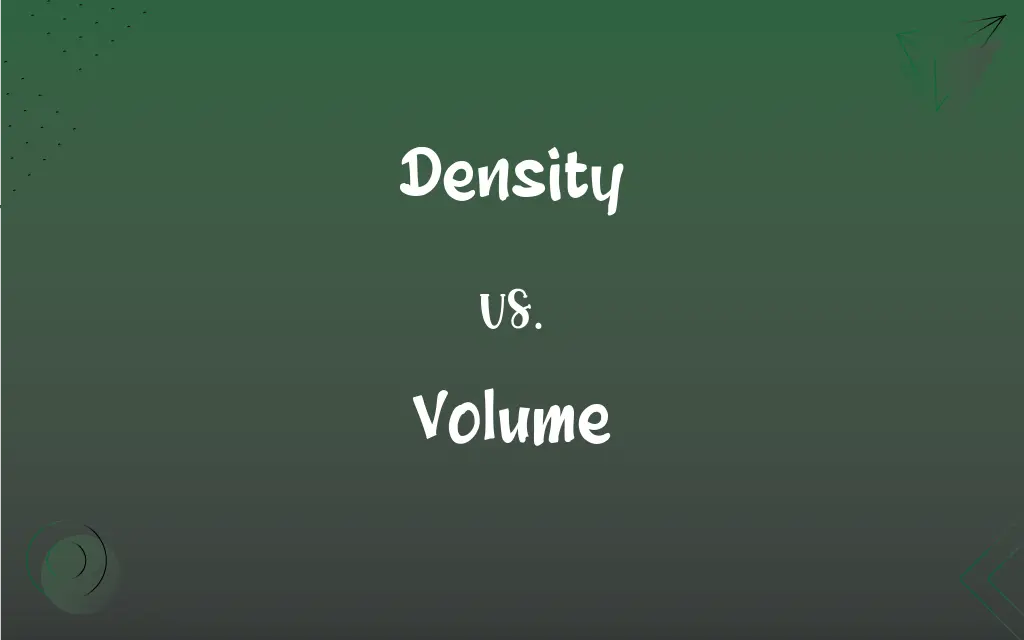Density vs. Volume: What's the Difference?
Edited by Harlon Moss || By Janet White || Published on January 16, 2024
Density is mass per unit volume of a substance, while volume is the amount of space an object occupies.

Key Differences
Density refers to how closely packed the particles of a substance are. In contrast, volume measures the total space that a substance or object occupies.
The density of an object remains constant at a given temperature and pressure, irrespective of its size. Volume, however, can vary greatly depending on the size and shape of the object.
Density is a property that helps determine whether an object will float or sink in a fluid. Volume is a measure used to determine how much space an object or substance fills.
Density is expressed in units like grams per cubic centimeter (g/cm³), while volume is measured in units such as liters or cubic meters.
Density is an intrinsic property of a material and does not change unless the material's composition changes. Volume can change with alterations in temperature and pressure.
ADVERTISEMENT
Comparison Chart
Definition
Mass per unit volume
Amount of space occupied
Measurement Units
G/cm³, kg/m³, etc.
Liters, cubic meters, etc.
Dependence
Independent of size and shape
Dependent on size and shape
Changes With
Composition changes
Temperature and pressure changes
Physical Relevance
Determines buoyancy, sinking or floating
Determines capacity, space occupancy
ADVERTISEMENT
Density and Volume Definitions
Density
Density is the mass of a substance per unit volume.
Lead has a higher density than aluminum.
Volume
Volume is the measure of space an object or substance occupies.
The volume of the tank is 2000 liters.
Density
Density indicates how compact a substance's particles are.
The density of a neutron star is incredibly high.
Volume
Volume can be calculated using geometric formulas.
The volume of a sphere is calculated as 4/3πr³.
Density
Density can vary within a substance, creating gradients.
Earth's atmosphere has a density gradient, decreasing with altitude.
Volume
Volume is used to measure the capacity of containers.
The bottle has a volume of 1.5 liters.
Density
Density determines an object's buoyancy in a fluid.
Objects with a density less than water float.
Volume
Volume quantifies the extent of an object in three dimensions.
The room's volume is 72 cubic meters.
Density
Density is a characteristic property of a material.
Gold's density helps in distinguishing it from fake imitations.
Volume
Volume is a common measurement for liquids and gases.
She measured out 100 milliliters of milk.
Density
The quality or condition of being dense.
Volume
A collection of written or printed sheets bound together; a book.
Density
The quantity of something per unit measure, especially per unit length, area, or volume.
Volume
One of the books of a work printed and bound in more than one book.
FAQs
How is density calculated?
Density is calculated as mass divided by volume.
Does density change with temperature?
Yes, for most substances, density decreases as temperature increases.
Can density be used to identify a substance?
Yes, density is a characteristic property that can help identify substances.
What units are used for density?
Common units include grams per cubic centimeter (g/cm³) or kilograms per cubic meter (kg/m³).
Is density the same as weight?
No, density is mass per volume, while weight is the force of gravity on an object.
What affects the density of a material?
Composition, temperature, and pressure can affect density.
What is density?
Density is the mass of a substance per unit volume.
Why do objects float or sink based on density?
Objects float if their density is less than the fluid they are in, and sink if more.
Can two objects have the same density but different masses?
Yes, if they have different volumes.
How is the volume of a liquid typically measured?
Usually with a graduated cylinder, measuring cup, or beaker.
How does density relate to buoyancy?
Buoyancy depends on the density difference between an object and the fluid it’s in.
What is volume?
Volume is the amount of space an object or substance occupies.
How is volume measured?
Volume can be measured in liters, cubic meters, cubic centimeters, etc.
Does the shape of an object affect its volume?
Shape doesn’t affect volume, but it determines how volume is calculated.
Can volume change with temperature?
Yes, most substances expand when heated, increasing their volume.
How do you find the volume of an irregular object?
By displacement method: measuring the volume of fluid displaced by the object.
How is the volume of a gas measured?
Typically by the space it occupies at a given temperature and pressure.
Is volume the same as capacity?
Capacity refers to the volume that a container can hold.
What is the difference between volume and area?
Volume measures three-dimensional space, while area measures two-dimensional space.
Does volume affect an object’s density?
Volume is part of the density calculation, but doesn’t directly affect density.
About Author
Written by
Janet WhiteJanet White has been an esteemed writer and blogger for Difference Wiki. Holding a Master's degree in Science and Medical Journalism from the prestigious Boston University, she has consistently demonstrated her expertise and passion for her field. When she's not immersed in her work, Janet relishes her time exercising, delving into a good book, and cherishing moments with friends and family.
Edited by
Harlon MossHarlon is a seasoned quality moderator and accomplished content writer for Difference Wiki. An alumnus of the prestigious University of California, he earned his degree in Computer Science. Leveraging his academic background, Harlon brings a meticulous and informed perspective to his work, ensuring content accuracy and excellence.






































































